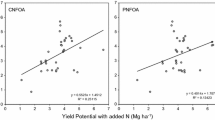Abstract
Research is ongoing to develop sensor-based systems to determine crop nitrogen needs. To be economic and to achieve wide adoption, a sensor-based site-specific application system must be sufficiently efficient to overcome both the cost disadvantage of dry and liquid sources of nitrogen relative to applications before planting of anhydrous ammonia and possible losses if weather prevents applications during the growing season. The objective of this study is to determine the expected maximum benefit of a precision N application system for winter wheat that senses and applies N to the growing crop in the spring relative to a uniform system that applies N before planting. An estimate of the maximum benefit would be useful to provide researchers with an upper bound on the cost of delivering an economically viable precision technology. Sixty five site-years of data from two dryland winter wheat nitrogen fertility experiments at experimental stations in the Southern Plains of the U.S.A. were used to estimate the expected returns from both a conventional uniform rate anhydrous ammonia (NH3) application system before planting and a precise topdressing system to determine the value of the latter. For prices of $0.55 and $0.33 kg−1 N for urea-ammonium nitrate (UAN) and NH3, respectively, the maximum net value of a system of precise sensor-based nitrogen application for winter wheat was about $22–$31 ha−1 depending upon location and assumptions regarding the existence of a plateau. However, for prices of $1.10 and $0.66 kg−1 N for UAN and NH3, respectively, the value was approximately $33 ha−1. The benefit of precise N application is sensitive to both the absolute and relative prices of UAN and NH3.


Similar content being viewed by others
References
Alchanatis V, Scmilivitch Z, Meron M (2005) In-field assessment of single leaf nitrogen status by spectral reflectance measurements. Precis Agric 6:25–39
Ehlert D, Schmerler J, Voelker U (2004) Variable rate nitrogen fertilisation of winter wheat based on a crop density sensor. Precis Agric 5:263–273
Frank MD, Beattie BR, Embleton ME (1990) A comparison of alternative crop response models. Am J Agric Econ 72:597–603
Grimm SS, Paris Q, Williams WA (1987) A von Liebig model for water and nitrogen crop response. Western J Agric Econ 12:182–192
Hurley TM, Oishi K, Malzer GL (2005) Estimating the potential value of variable rate nitrogen applications: A comparison of spatial econometric and geostatistical models. J Agric Resour Econ 30:231–249
Kastens TL, Schmidt JP, Dhuyvetter KC (2003) Yield models implied by traditional fertilizer recommendations and a framework for including nontraditional information. Soil Sc Soc Am J 67:351–364
Kletke D, Doye D (2001) Oklahoma Farm and Ranch Custom Rates, 2001–2002. Oklahoma Cooperative Extension, Current Report CR−205
Lambert D, Lowenberg-Deboer J (2000) Precision Agriculture Profitability Review. Site-Specific Management Center, Purdue University. Found at: http://www.agriculture.purdue.edu/ssmc/Frames/newsoilsX.pdf
Lambert DM, Lowenberg-Deboer J, Malzer GL (2006) Economic analysis of spatial-temporal patterns in corn and soybean response to nitrogen and phosphorus. Agron J 98:43–54
Lanzer EA, Paris Q (1981) A new analytical framework for the fertilization problem. Am J Agric Econ 63:93–103
Perrin RK (1976) The value of information and the value of theoretical models in crop response research. Am J f Agric Econ 58:54–61
Phillips SB, Keahey DA, Warren JG, Mullins GL (2004) Estimating winter wheat tiller density using spectral reflectance sensors for early-spring, variable-rate nitrogen applications. Agron J 96:591–600
Raun WR, Solie JB, Johnson GV, Stone ML, Lukina EV, Thomason WE, Schepers JS (2001) In-season prediction of potential grain yield in winter wheat using canopy reflectance. Agron J 93:131–138
Schächtl J, Huber G, Maidl F-X, Stickse E, Schulz J, Haschberger P (2005). Laser-induced chlorophyll fluorescence measurements for detecting the nitrogen status of wheat (Triticum aestivum L.) canopies. Precis Agric 6:143–156
Tembo G, Brorsen BW, Epplin FM (2003) Linear response stochastic plateau functions. J Agric Appl Econ 35:445
USDA (2005a) Commodity Costs and Returns. The Economics of Food, Farming, Natural Resources, and Rural America, Economic Research Service. Found at: http://www.ers.usda.gov/Data/costsandreturns/testpick.htm
USDA (2005b) Fertilizer Use and Price. Nitrogen used on wheat, rate per fertilized acre receiving nitrogen, selected States for 1964–2003. Found at: http://www.ers.usda.gov/Data/FertilizerUse/Tables/Fert%20Use%20Table%2028.xls
Waugh DL, Cate RB, Nelson LA (1973) Discontinuous Models for Rapid Correlation, Interpretation and Utilization of Soil Analysis and Fertilizer Response Data. North Carolina State University Technical Bulletin No. 7, Soil Fertility Evaluation and Improvement Program, Raleigh
Acknowledgements
The authors thank the editor and two anonymous journal reviewers for their constructive comments.
Author information
Authors and Affiliations
Corresponding author
Additional information
This is journal paper AEJ-260 of the Oklahoma Agricultural Experiment Station, project H-2574.
Rights and permissions
About this article
Cite this article
Biermacher, J.T., Epplin, F.M., Wade Brorsen, B. et al. Maximum benefit of a precise nitrogen application system for wheat. Precision Agric 7, 193–204 (2006). https://doi.org/10.1007/s11119-006-9017-6
Published:
Issue Date:
DOI: https://doi.org/10.1007/s11119-006-9017-6




